Wake up Christmas morning to these soft & fluffy eggnog cinnamon rolls! They're made with a yeasted dough enriched with eggnog, and just before baking they're doused with even more eggnog. Once baked to golden, gooey perfection, top them with a sweet eggnog icing and freshly grated nutmeg.
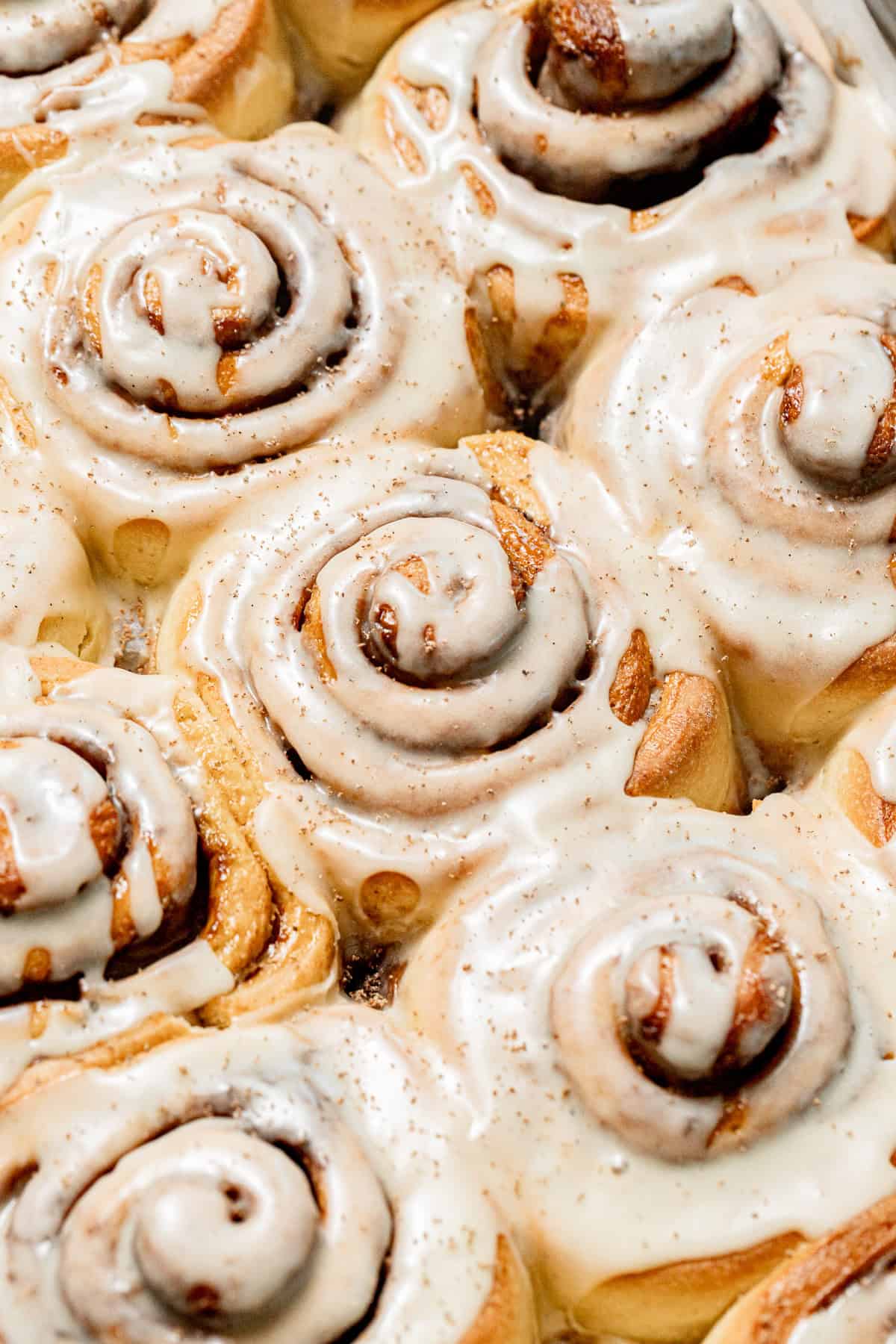
Jump to Recipe
Why you'll love these eggnog cinnamon rolls
- Soft & Pillowy Brioche: My go-to brioche recipe turns into a soft and supple dough after a slow & cold overnight rise that's so nice to roll out and shape into cinnamon rolls. As an enriched bread, it yields a buttery, yeasty flavor with a pillowy soft texture that is utterly irresistible in the form of a cinnamon roll.
- Eggnog Cream Soaked: The richness from the eggnog is soaked up by the brioche as it bakes and becomes even softer and fluffier.
- Overnight Proof: By letting the dough rise slowly in a cold environment, it not only develops more depth of flavor, but also gives you more flexibility with the timing of baking the cinnamon rolls. So you can make the dough the night before Christmas, and the morning of shape them, bake, and enjoy!
For more cinnamon roll recipes, try my Mini Cinnamon Rolls with Heavy Cream, Cranberry Orange Cinnamon Rolls, and Brown Butter Cardamom Cinnamon Rolls.

Ingredient Notes

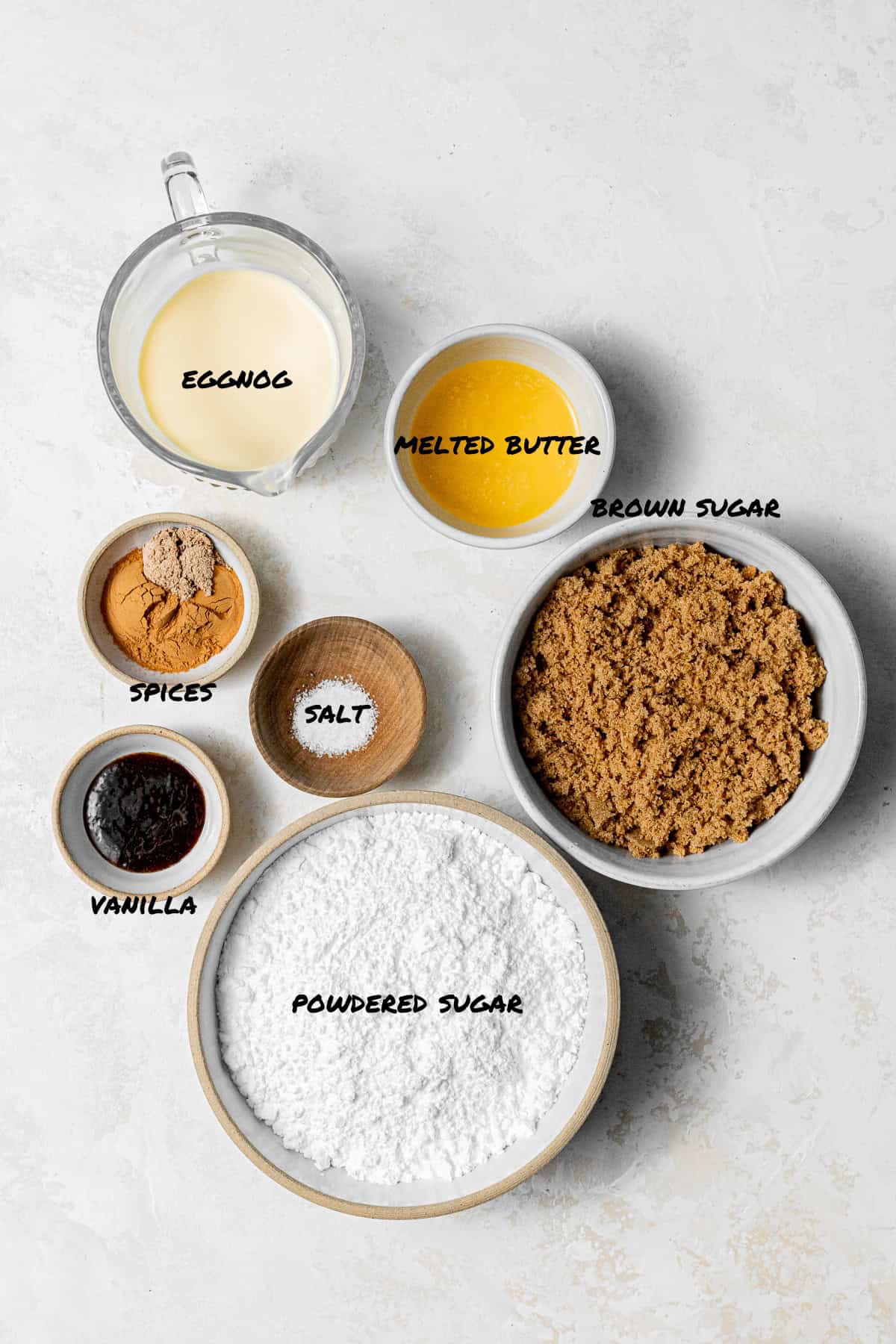
- Flour: Use unbleached all-purpose flour for the best flavor and overall results.
- Eggnog: Rather than using milk, we're using eggnog to enrich the dough and give it a festive flavor!
- Sugar: A small amount of granulated sugar is mixed in with the eggnog and yeast to help activate the yeast, as well as give the brioche a richer color on top as it bakes.
- Yeast: Feel free to use instant or active dry yeast.
- Vanilla: Add a touch of pure vanilla bean paste or extract for more depth of flavor.
- Butter: Use high quality European-style butter for optimum flavor and overall result. I recommend Kerrygold.
See recipe card for full information on ingredients and individual quantities.
Step by Step Instructions
Here are step by step photos and instructions on how to make this eggnog cinnamon roll recipe! For the full ingredient list and method, see the recipe card at the end of this post.
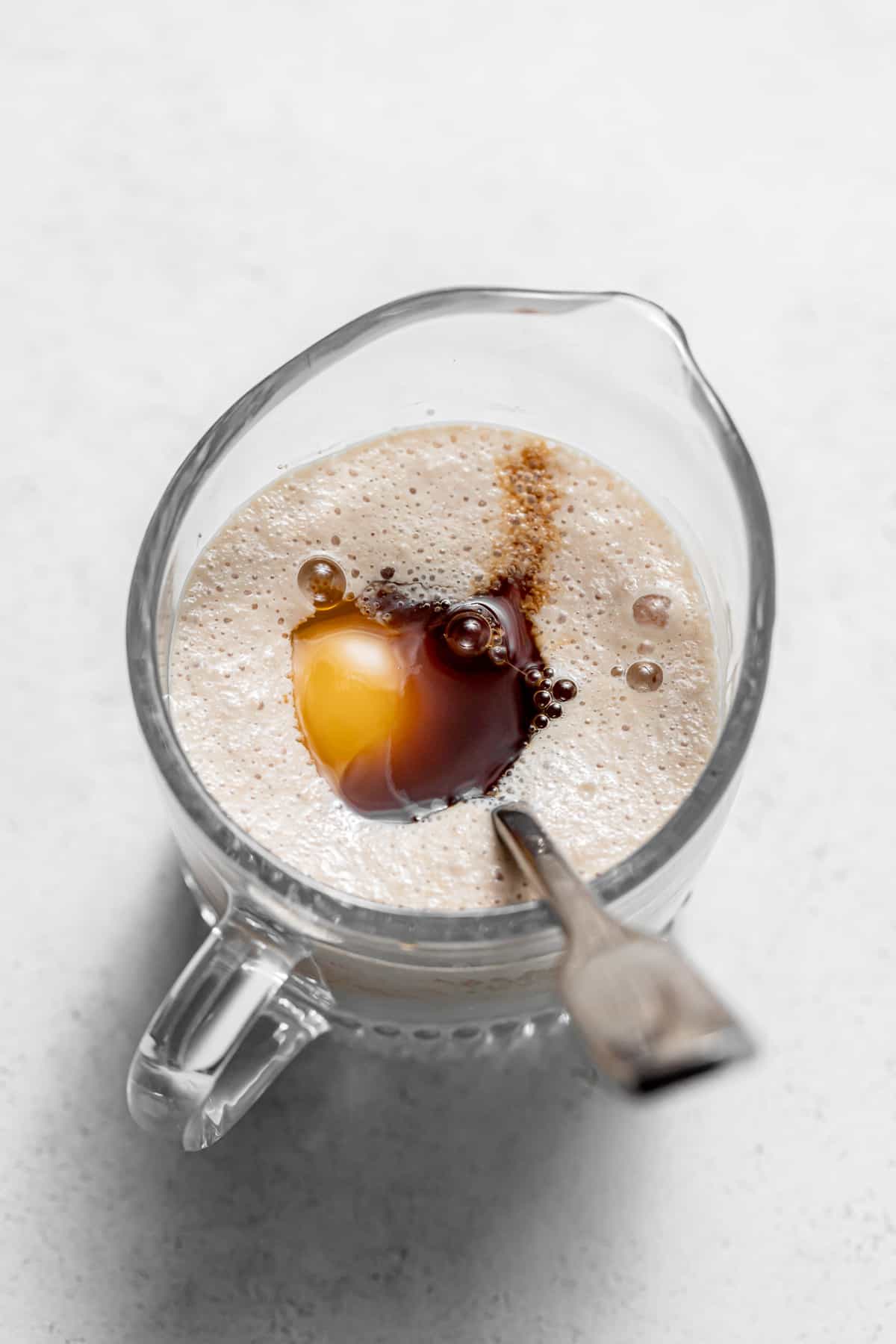

STEP 1: Activate the yeast; Mix in eggs & vanilla. In a glass measuring cup, heat the eggnog to 110 degrees F and stir in the sugar and yeast. If using active dry yeast, allow to sit for 15 minutes for the yeast to activate. If using instant yeast, simply move on to the next step. Mix the eggs and vanilla into the eggnog, yeast mixture.
STEP 2: Add wet ingredients to dry. In the bowl of a stand mixer fitted with a dough hook, mix the flour, salt, and nutmeg together. Pour the wet ingredients into the flour and mix on low-medium speed for about 3 minutes, or until it forms a ball around the hook.


STEP 3: Mix in the butter. Add in a few pieces of butter at a time, allowing them to fully incorporate before adding more. Once all of the butter is incorporated, turn the mixer up to medium-high speed and mix for 8-12 minutes, until a smooth and supple dough forms. The dough will eventually pull away from the sides of the bowl and have a silky smooth texture with minimal stickiness.
STEP 4: Preform windowpane test. To check if the dough is ready, use the windowpane test - tear off a small piece and carefully spread it out to see if you can see the light through it without it tearing. If it tears, mix for another minute or two and check again.

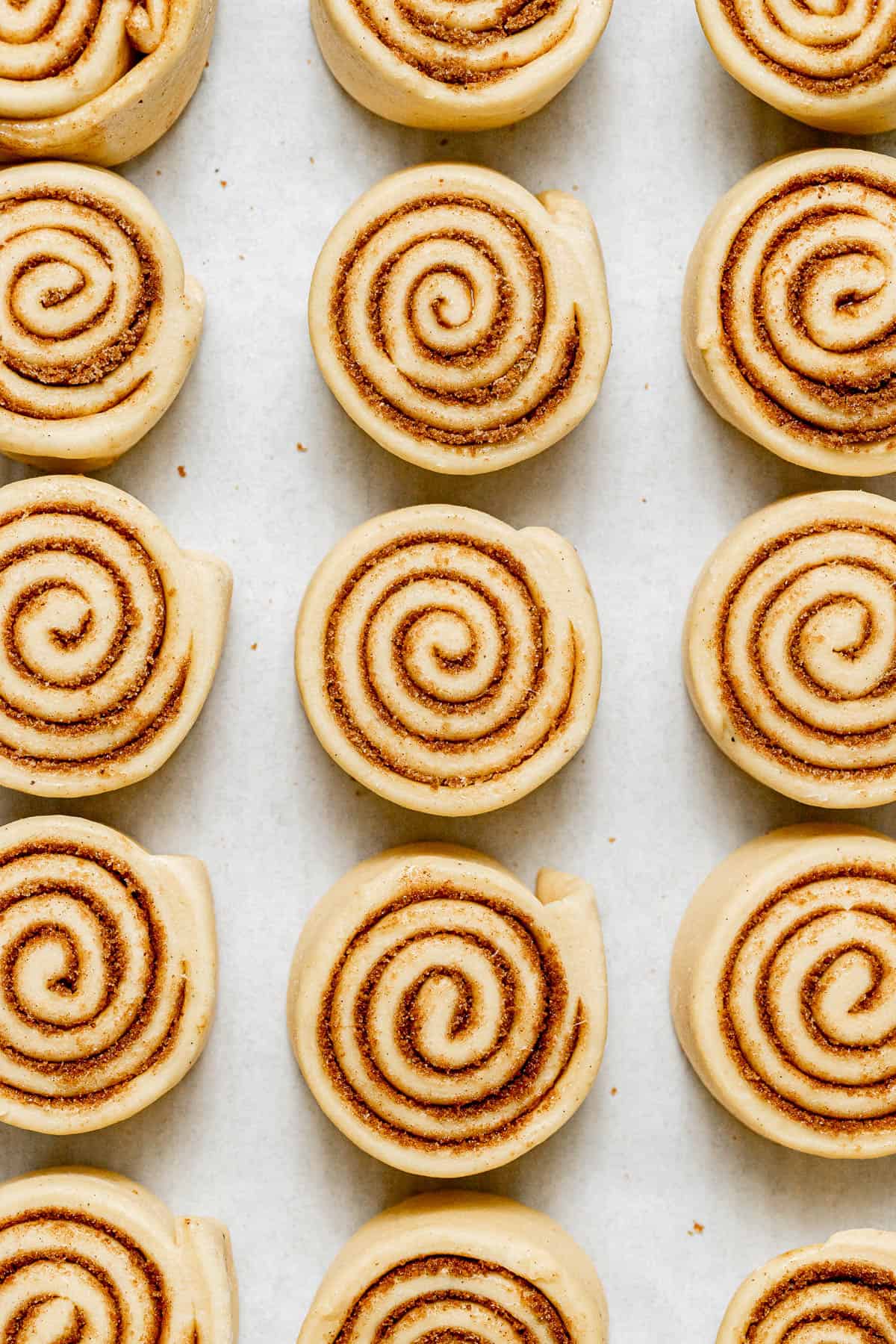
STEP 5: Proof overnight. Once the dough is ready, transfer it to a lightly greased bowl, cover, and allow to proof in the fridge for two hours. Alternatively, you can let the dough rise in a warm place for about 1 hour or until doubled in size.
STEP 6: Assemble the rolls & proof. On a lightly floured surface, roll the dough out to a long rectangle about 24"x14". Sprinkle the brown sugar, cinnamon, and nutmeg evenly over the top. Roll the dough up into a log. Use a serrated knife to score lines every 1 ½” to get 15 rolls. Use unflavored dental floss to cut each roll by placing the floss under the dough, wrapping around, and pulling to cut through. Arrange the rolls in a 9"x13” pan. Cover with plastic wrap and allow to rise for about 1 hour or until nearly room temperature, but still slightly cool to the touch. When pressed with a finger, the dough will slowly spring back.


STEP 7: Bake. Just before baking, pour the eggnog all over the cinnamon rolls. Bake for about 25-30 minutes or until evenly golden on top.
STEP 8: Add the glaze. Make the glaze, and once the cinnamon rolls come out of the oven, immediately pour it on top.
Expert Baking Tips
- Proof the dough overnight: I recommend allowing your brioche dough to rise slowly overnight in the fridge. Cold dough is so much nicer to work with! But you can also let it proof at room temperature for one hour and make the cinnamon rolls immediately.
- Bake the dough within 24 hours: To find that sweet spot between properly proofed with a developed flavor and over-fermented, I recommend giving the dough at least 5 hours to rise in the fridge, but no more than 24 hours.
- Cut the dough with dental floss. To get a clean cut of each cinnamon roll, use unflavored dental floss rather than a knife.

Recipe FAQs
Using a stand mixer with the dough hook, mix the wet and dry ingredients on low-medium speed for a few minutes until it forms a ball around the hook.
2. Slowly begin incorporating the room temperature butter as it mixes on medium speed. It is very important to use room temperature butter in order for it to incorporate properly.
3. Once all of the butter is incorporated, turn the speed up to high and mix for about 8 minutes or until the dough passes the windowpane test.
The windowpane test is used to tell when the brioche has developed enough gluten. To check if the dough is ready, tear off a small piece and carefully spread it out to see if you can see the light through it without it tearing. If it tears, mix for another minute and check again.
These cinnamon rolls are best the day it's baked, however they can be stored at room temperature in an airtight container for 2-3 days.
Baking in Grams
All of the recipes on this blog are carefully developed with gram measurements so you can easily recreate them in your own kitchen with success. Volume measurements are extremely inaccurate and leave room for significant errors. Not all measuring cups are made equally, so your one cup of flour will be different from my one cup of flour. By providing precise measurements in grams (aside from minor ingredients, which are given in tsp/tbsp), you can make these recipes accurately and with less cleanup! All you need is this kitchen scale.
If this still isn't enough to convince you, I have provided volume measurements in the recipe card. If you are interested in understanding the conversions, this is the best conversion chart.
But trust me, once you try baking in grams you'll never turn back!
Happy baking! x
Other Christmas recipes to try
If you tried this recipe, I'd love to know how it turned out for you! Leave a star rating & review below and post a picture (or video!) on Instagram and tag me so I can see your bakes! Not ready to make this recipe yet? Click the heart button on the right of your screen to save it for later 🙂
📖 Recipe
Eggnog Cinnamon Rolls
Ingredients
For the dough
- 170 g (¾ cup) eggnog, warmed to 110 degrees F
- 30 g (2 ½ tablespoon) granulated sugar
- 9 g (1 tablespoon) instant or active dry yeast
- 3 eggs, room temp
- 1 teaspoon vanilla bean paste
- 450 g (3 ¾ cups) all-purpose flour
- ½ teaspoon kosher salt
- ½ teaspoon nutmeg
- 127 g (½ cup + 1 tbsp) unsalted butter, room temp
For the filling & assembly
- 160 g (¾ cup) dark brown sugar
- 6 g (1 tablespoon) cinnamon
- ½ teaspoon nutmeg
- 113 g (½ cup) eggnog, to pour over cinnamon rolls prior to baking
For the icing
- 227 g (2 cups) powdered sugar
- 28 g (2 tablespoon) unsalted butter, melted
- 56 g (¼ cup) eggnog
- ¼ teaspoon vanilla bean paste
- ¼ teaspoon kosher salt
Instructions
For the dough:
- In a glass measuring cup, heat the eggnog to 110 degrees F and stir in the sugar and yeast. If using active dry yeast, allow to sit for 15 minutes for the yeast to activate. If using instant yeast, simply move on to the next step.
- Mix the eggs and vanilla into the eggnog, yeast mixture.
- In the bowl of a stand mixer fitted with a dough hook, mix the flour, salt, and nutmeg together.
- Pour the wet ingredients into the flour and mix on low-medium speed for about 3 minutes, or until it forms a ball around the hook.
- Add in a few pieces of butter at a time, allowing them to fully incorporate before adding more.
- Once all of the butter is incorporated, turn the mixer up to medium-high speed and mix for 8-12 minutes, until a smooth and supple dough forms. The dough will eventually pull away from the sides of the bowl and have a silky smooth texture with minimal stickiness. To check if the dough is ready, use the windowpane test - tear off a small piece and carefully spread it out to see if you can see the light through it without it tearing. If it tears, mix for another minute or two and check again.
- Once the dough is ready, transfer it to a lightly greased bowl, cover, and allow to proof in the fridge for two hours. Alternatively, you can let the dough rise in a warm place for about 1 hour or until doubled in size.
For assembly:
- On a lightly floured surface, roll the dough out to a long rectangle about 24"x14".
- Sprinkle the brown sugar, cinnamon, and nutmeg evenly over the top.
- Roll the dough up into a log. Use a serrated knife to score lines every 1 ½” to get 15 rolls. Use unflavored dental floss to cut each roll by placing the floss under the dough, wrapping around, and pulling to cut through.
- Arrange the rolls in a 9"x13” pan. Cover with plastic wrap and allow to rise for about 1 hour or until nearly room temperature, but still slightly cool to the touch. When pressed with a finger, the dough will slowly spring back.
- While the rolls are proofing, preheat the oven to 350 degrees F.
- Just before baking, pour the eggnog all over the cinnamon rolls. Bake for about 25-30 minutes or until evenly golden on top.
For the glaze:
- In a medium bowl, whisk together the powdered sugar, melted butter, eggnog, vanilla, and salt until smooth.
- Heat in the microwave for about 15 seconds to bring to a pourable consistency.
- Once the cinnamon rolls come out of the oven, immediately pour the glaze on top.
Notes
- Proof the dough overnight: I recommend allowing your brioche dough to rise slowly overnight in the fridge. Cold dough is so much nicer to work with! But you can also let it proof at room temperature for one hour and make the cinnamon rolls immediately.
- Bake the dough within 24 hours: To find that sweet spot between properly proofed with a developed flavor and over-fermented, I recommend giving the dough at least 5 hours to rise in the fridge, but no more than 24 hours.
- Cut the dough with dental floss. To get a clean cut of each cinnamon roll, use unflavored dental floss rather than a knife.









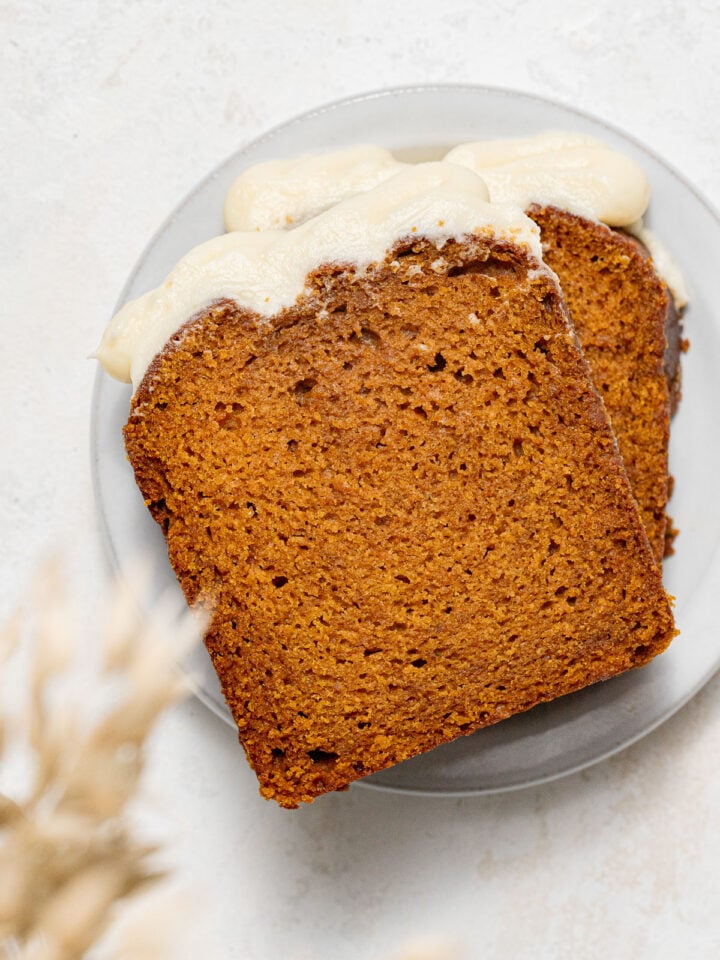
Comments
No Comments